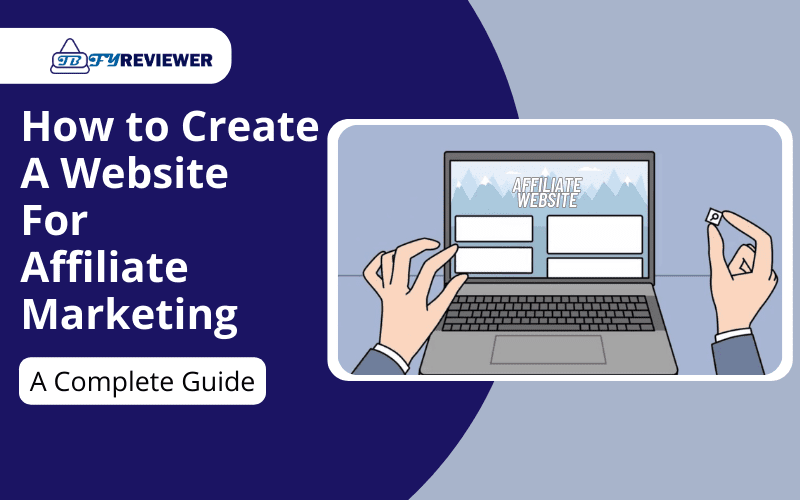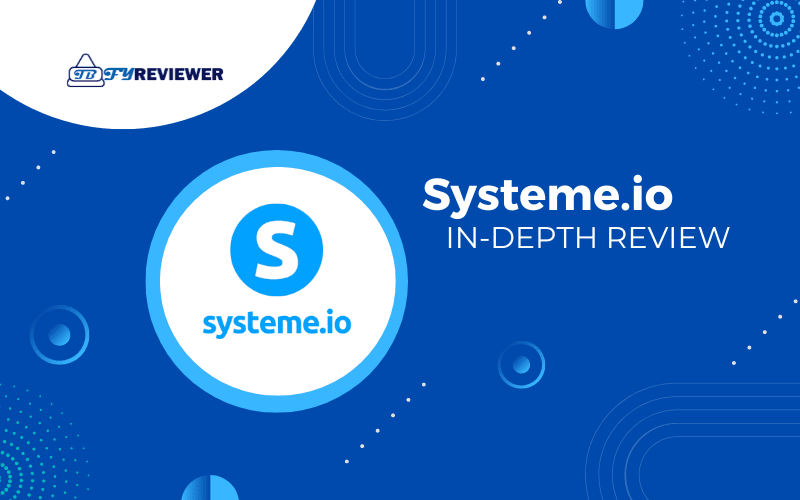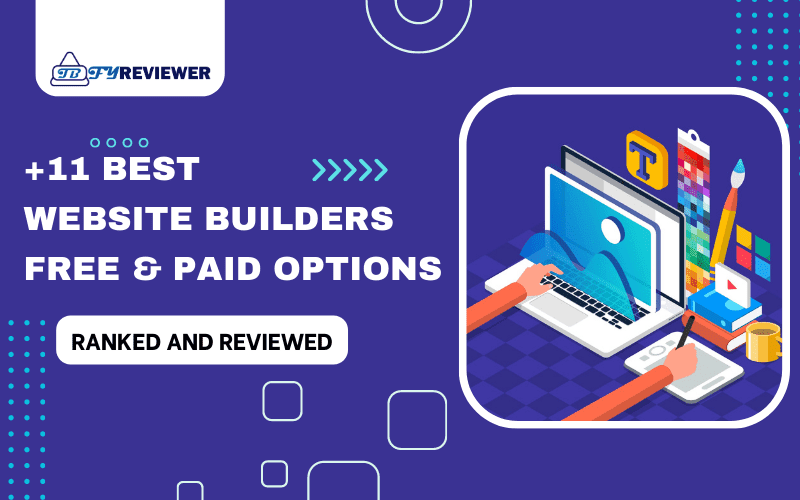Join TbfyReviewer’s newsletter to receive every new article.
How to Create a Website for Affiliate Marketing: A Complete Guide
Hossam jamjama
- August 31, 2023

Are you interested in earning passive income through affiliate marketing? One of the most important assets to have is a website.
Creating a website for affiliate marketing may seem challenging, but it doesn’t have to be.
In this step by step guide, we will show you how to create a website for affiliate marketing that not only looks professional but also converts visitors into customers.
As we explore the essential steps required to build an effective affiliate marketing website, you’ll discover everything you need to know about how to create a website for affiliate marketing that will help you succeed in this lucrative business.
Importance of Having a Website for Affiliate Marketing
Before diving into the creation process, it is crucial to understand why having a website is important in affiliate marketing. Unlike social media or other platforms that limit your reach, a website gives you greater control over your online presence.
Having a website gives you a platform to promote products and services as an affiliate marketer.
Your website will serve as the place where you recommend and review products that your target audience could benefit from.
It also provides opportunities to showcase your niche expertise and encourage visitors to take action by clicking on your affiliate links.
With a website, you can build your brand, connect with your audience, and promote your affiliate products effectively.
Overview of Website Creation for Affiliate Marketing
Creating a successful affiliate marketing website involves several stages.
Some of these stages that you need to focus on include:
- Niche selection
- Market research
- Domain name and web hosting
- Website design and development
- SEO optimization
- Website maintenance and analytics
- Legal considerations
Let’s delve into each of these steps in detail.
Niche Selection and Market Research
Picking the right niche is the first step when starting an affiliate marketing website.
Here are some tips on finding the right niche:
Identifying Your Niche
Consider topics that you have knowledge or interest in; your passion will motivate you to create content regularly.
Also, consider areas with high profitability potential based on their audience size and consumer spending habits.
Conducting thorough market research helps you identify:
Conducting Market Research
Market research involves analyzing the competition, identifying the target audience, and selecting the right products to promote.
Analyzing Your Competition
Identify who your competitors are, what they offer, and how their sites are structured.
Knowing your competition provides insights into their strengths, weaknesses, opportunities, and threats (SWOT analysis).
Check what they are offering so that you know how you can differentiate yourself from them.
Use this information to identify gaps in the market and find opportunities that you can capitalize on.
Identifying Your Target Audience
Once you know your niche competition, it’s essential to narrow down your target audience’s profile by analyzing their psychographics (interests, values, attitudes) and demographics (age range, gender location).
This insight improves targeting effectiveness with relevant content based on interest.
Choosing the Right Products to Promote
Research products relevant to your niche from affiliate networks such as Amazon Associates, ClickBank, or Commission Junction.
Based on the market demand, target audience, cost potential, and niche relevance, you can choose the right products to promote.
Domain Name and Web Hosting
Picking a domain name and web hosting provider is vital for your website’s success. Here are some essential steps to follow:
Choosing a Domain Name
Choosing a domain name should take into account how memorable, brandable, unique, and keyword-rich it is.
Ensure that your domain name is easy to spell and relates to your niche.
Selecting a Web Hosting Provider
Selecting a reliable web hosting provider requires consideration of factors like:
- Speed
- uptime guarantees
- customer support response time
- SSD storage and bandwidth limitations
- server location
- security features such as HTTPS encryption.
Consider their pricing plans to ensure they fit within your budget.
From our list of the best web hosting providers, you can select the best one for your website.
Setting up Your Web Hosting Account
Once you have selected your hosting provider, register an account, choose a hosting package according to your ultimate goals, and configure your website using cPanel or other admin tools provided by the provider.
Setting up your web hosting account involves:
- Selecting the right type of hosting for your needs (shared hosting vs. VPS vs dedicated servers).
- Installing WordPress via one-click installers or manual install (If you select WordPress).
- Configuring SSL certificates and DNS settings after linking your domain with hosting.
Website Design and Development
Designing and developing a website can be a challenging task unless you have the right tools at hand. Here are some tips on how to create an effective website design for affiliate marketing:
Selecting a Website Builder
You must choose the website builder that meets your skill level, budget limit as well as its ease of use. The most popular ones include WordPress.org, Wix, Squarespace, and Weebly.
They are user-friendly and offer numerous templates designed for affiliate marketers.
WordPress.org offers maximum customization control over your design.
You can check out our list of the best website builders, and choose the right one that fits your budget and needs.
Choosing a Website Theme
Choose a theme that complements your niche adequately.
Themes designed for affiliate marketing generally feature product displays, ready-to-use landing pages, built-in blog pages, and other relevant features such as CTAs (call-to-actions) or promotional boxes.
Your selected theme impacts speed optimization for fast loading pages and flexibility for mobile responsiveness.
You can either go with a free or paid theme based on factors like the type of layout needed, and color combos available.
Customizing Your Website Design
Customize your website’s look and feel using branding elements like colors, logos, and fonts.
Ensure that the layout is user-friendly with simple navigation menus that allow readers to find what they’re looking for quickly.
Branding
Create a unique brand that reflects your niche and resonates with your target audience.
It’s essential to develop compelling branding elements like logos that attract customers’ attention toward promotions or deals that are running on their platforms.
Consistency in branding is key to building trust and driving conversions.
Layout
Your website’s overall look and feel needs to be visually appealing by balancing colors and positioning different design elements that guide visitors toward content relevant to them.
- Optimize your website design for aesthetic appeal and ease of use.
- Strike a balance between text, images, videos, and CTAs to keep readers engaged.
Navigation
Use navigation menus wisely to keep visitors engaged while ensuring a seamless user experience.
Create an intuitive navigation system with drop down menus and internal linking that makes it easy for users to access different sections of your website.
This also will help search engines find and index your pages easily.
Developing Website Content
Creating high quality content for your affiliate marketing website is vital to attract and engage your target audience.
Your website content serves the purpose of educating, informing, and persuading your visitors so that they make an informed purchase decision.
Here are some essential pages you should create:
Homepage
Your homepage should visually represent your brand/site essence through images, videos, and text.
Create a compelling homepage that introduces your brand and conveys the core message of your website.
Place CTAs relevant to popular products or services on your homepage.
About Page
Your About section should detail out what your website is all about, how you operate, and why visitors should trust you when it comes to recommendations.
Introduce yourself and explain why you are passionate about the niche you have chosen.
Use this page to build trust with readers and establish yourself as an authority in your niche.
Product Review Pages
Produce detailed reviews of the products or services you promote, highlighting their benefits, features, pros, and cons.
Provide enough information to help readers make informed purchasing decisions.
Blogging
Blogging is an ideal way to communicate regularly with your audience, monetize your blog through affiliate marketing, and expand your website’s reachability.
A blog allows you to publish regular content updates on topics related to your niche.
Create blog posts that provide value, entertain, or inform readers about topics they may be interested in; add affiliate links within the post’s text where appropriate.
SEO Optimization
Search engine optimization helps improve your website rankings on search engine result pages (SERPs) by optimizing them for factors like:
- Keywords Density
- Title tags
- Meta description
- Content optimization
- Header tags
- Internal linking
This helps you get plenty of organic traffic and generates more leads and sales. You can read our SEO Tutorial for Beginners to understand the SEO basics.
Here are some tips on how to optimize your website for search engines:
Keyword Research for Affiliate Marketing
Use keyword research tools such as Ahrefs or KeySearch to identify high-volume keywords related to your niche that you can use throughout your site’s content.
Use long-tail keywords in URLs and spread them across the body of the articles without stuffing them for natural readability.
On page SEO for Affiliate Marketing
On-page SEO involves optimizing elements on your website that impact your ranking on search engines.
Make sure you properly optimize for all on page SEO elements:
Title Tags
The title tag displays what the page is all about on SERPs.
Include relevant keywords in your title tags to help search engines understand the purpose of a page.
Meta Descriptions
The meta description offers a sneak-peek into what visitors can expect upon clicking through to your page. They are short snippets that provide readers with an overview of what they should expect on a page.
Use them to entice readers and include relevant keywords.
Header Tags
Make use of headers like H1, H2, H3 headings in breaking down lengthy paragraphs into scannable chunks of information that keep readers engaged.
This makes content more readable for both users and search engines.
Content Optimization
Optimize the structure and formatting of your content using bullet points or numbered lists that help visitors read fast.
Produce high-quality content that targets specific keywords while providing value to readers.
Mix up text, images, and videos for best results.
Internal Linking
Link relevant internal pages to each other, creating a web of related topics that keep readers engaged and lowers your website’s bounce rate.
Make use of internal links to drive more page views and increase user engagement and dwell time.
To make these tasks done successfully you need an all-in-one SEO tool, you can pick the right one for you from our list of the best SEO tools.
Off page SEO for Affiliate Marketing
Off page SEO refers to the practices you undertake outside of your website to improve its ranking on SERPs. Here is what you should focus on:
Link Building
Choose reputable websites for linking that provide backlinks to your website. Reach out to other bloggers to exchange links with other authoritative sites.
You can also build authoritative backlinks from reputable websites within your niche through guest posts, collaborations, or broken link outreach.
Guest Blogging
Guest posting on relevant sites provides an avenue to promote your affiliate promotion blog or website.
Write for other websites within your niche; include a link back to your website within the post and author bio sections where appropriate.
Social Media Marketing
Promote your affiliate website through social media platforms like Facebook, Instagram, Twitter, and Pinterest.
These platforms have huge potential to drive traffic, generate leads, and boost conversions through effective audience engagement.
Share high quality content regularly while also engaging with followers to expand your reach.
Website Maintenance and Analytics
Maintaining a website is an ongoing process that requires regular updates and optimization.
To aid in maintaining your website for affiliate marketing:
Regular Website Maintenance
Periodically check for broken links or outdated content; backup your site regularly in case of loss of data due to unexpected events such as hacking or server crashes.
Website Analytics
Using a tool like Google Analytics helps keep track of site traffic patterns, visit duration as well as bounce rates. It also tracks visitor behavior; monitors metrics such as organic traffic, affiliate earnings, and conversion rates.
This makes it vital to check which pages perform well in terms of more clicks or higher Return on Investment (ROI).
Assessing Website Performance
Quantify how well the site is performing through metrics such as organic traffic growth over time, and consistency in earnings generated from commissions from sales driven by promoted services/products multiplied by conversion rates over time.
You can also assess your website’s performance through tracking KPIs; adjust your content, layout, or site structure accordingly to improve results.
Legal Considerations
Affiliate marketers must stay transparent as per regulatory guidelines that require conspicuously made disclosures about compensation arrangements and Privacy policies that display personal information handling practices.
Ensure that you comply with the relevant legal requirements for affiliate marketing websites in your jurisdiction. Some essential requirements include:
Disclosure Requirements for Affiliate Marketing
Disclose to readers in a visible and understandable way that you purchase and use the products you review and promote.
Privacy Policy
Create a privacy policy that outlines how you handle customer data collected through your website.
Terms and Conditions
Clear, concise terms and conditions protect you as an affiliate marketer and help inform readers of what they can expect when interacting with your website.
Make sure to create terms and conditions policies that are industry-standard-based regulations.
Recap of Key Points
Creating a successful affiliate marketing website requires careful planning and execution.
Start by choosing the right niche, designing an attractive website, optimizing it for search engines, promoting it through social media channels, and analyzing its performance regularly while complying with all relevant legal requirements.
Final Thoughts
Creating a website for affiliate marketing requires the investment of time, effort, and research that results in creating a hub for providing value to your target audience. This can be challenging but also rewarding if done correctly.
Remember to focus on producing high-quality content regularly while engaging with your target audience to build brand loyalty over time.
In summary, by following the steps highlighted in this article on how to create a website for affiliate marketing, you can set up a successful site that will generate revenue and attract lasting long term partnerships with your affiliates.
- Last Update OnAugust 31, 2023
- ByHossam jamjama

Hossam Jamjama
Hey, it’s Hossam. I am a full time digital marketer & an online business owner. I write guides and in-depth reviews of the best SaaS products available. To help businesses make informed decisions about picking the right one for them.
Disclosure: TbfyReviewer is a participant in various affiliate programs, which means we may earn a commission when you buy something through links on our site at no cost to you if you decide to purchase a paid plan. You can read our affiliate disclosure.
Table Of Content
- Importance of Having a Website for Affiliate Marketing
- Overview of Website Creation for Affiliate Marketing
- Niche Selection and Market Research
- Domain Name and Web Hosting
- Website Design and Development
- SEO Optimization
- Website Maintenance and Analytics
- Legal Considerations
- Recap of Key Points
- Final Thoughts


